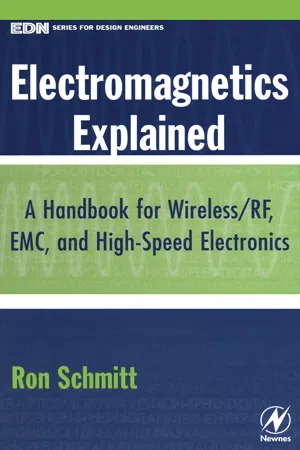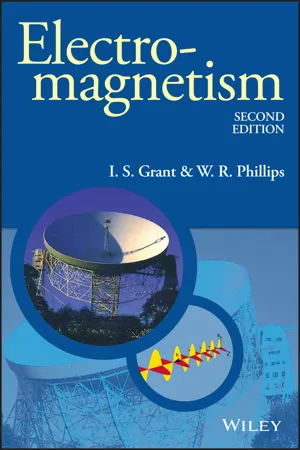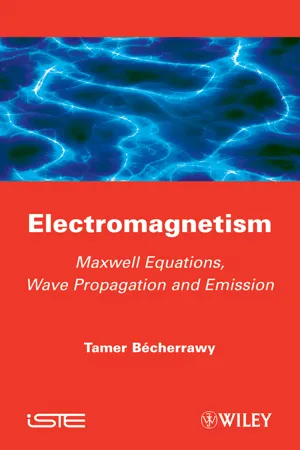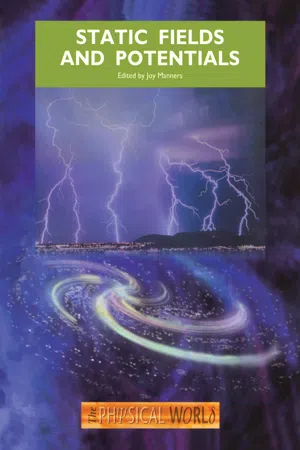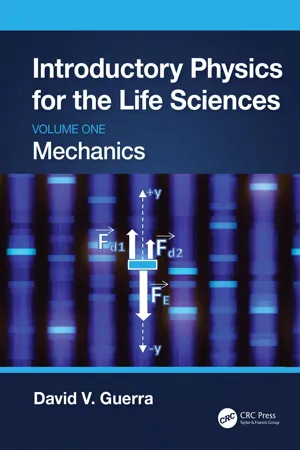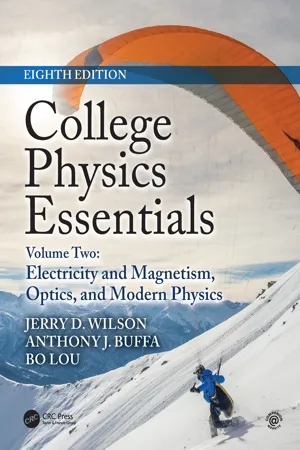Physics
Electric Force
Electric force is a fundamental force of nature that describes the attraction or repulsion between charged particles. It is responsible for the interactions between electrons and protons within atoms, as well as the behavior of electrically charged objects. The strength of the electric force is determined by the magnitude of the charges and the distance between them, as described by Coulomb's law.
Written by Perlego with AI-assistance
Related key terms
Related key terms
1 of 4
Related key terms
1 of 3
11 Key excerpts on "Electric Force"
- eBook - ePub
- A. L. Stanford, J. M. Tanner(Authors)
- 2014(Publication Date)
- Academic Press(Publisher)
11Electric Charge and Electric Fields
Publisher Summary
This chapter begins our study of electric and magnetic phenomena, collectively called electromagnetism . Electromagnetic forces, like gravitational forces, are fundamental interactions that occur between particles. Just as mass is that property of matter that engenders gravitational attraction, electric charge is a property of certain fundamental particles, like electrons and protons, that causes electromagnetic interaction. Our investigation of electrostatics , the analysis of interactions between charges at rest, is based on a force law for charges and on the concept of electric fields. The force law for charges, called Coulomb’s law, is the electrical analogue of the law of universal gravitation. The electric field is an abstract concept used to characterize how the presence of charge alters the properties of the space around that charge.11.1 Electric Charge and Coulomb’s Law
Electric charges exist in two forms, called positive charge and negative charge . The natural unit of charge is the positive charge of a proton or the negative charge of an electron. The SI unit of charge is the coulomb (C), which will be defined later in terms of electric current. This unusual definition is used because of the difficulty of making reproducible measurements on quantities of charge. For now, we will use as a measure of charge the experimentally obtained value for e , the magnitude of the charge of an electron or proton:e = 1.60 ×(11-1)10C− 19(11-1)Equivalently, a coulomb is the quantity of charge carried by 6.25 × 1018 electrons.An electron (or proton) bears the smallest unit of charge found in nature, so any quantity of charge q occurs as an integral number n of the basic charge e , or q = ne . Thus, as with any physical quantity made up of a number of “minimum parcels,” we say that electric charge is quantized; the least quantity that occurs, the quantum of charge, is the electronic charge e - eBook - ePub
Electromagnetics Explained
A Handbook for Wireless/ RF, EMC, and High-Speed Electronics
- Ron Schmitt(Author)
- 2002(Publication Date)
- Newnes(Publisher)
By convention, the electric field is always drawn from positive to negative. It follows that the force lines emanate from a positive charge and converge to a negative charge. Furthermore, the electric field is a normalized force, a force per charge. The normalization allows the field values to be specified independent of a second charge. In other words, the value of an electric field at any point in space specifies the force that would be felt if a unit of charge were to be placed there. (A unit charge has a value of 1 in the chosen system of units.)Electric field = Force field as “felt” by a unit chargeTo calculate the force felt by a charge with value, q, we just multiply the electric field by the charge,The magnitude of the electric field decreases as you move away from a charge, and increases as you get closer. To be specific, the magnitude of the electric field (and magnitude of the force) is proportional to the inverse of the distance squared. The electric field drops off rather quickly as the distance is increased. Mathematically this relation is expressed aswhere r is the distance from the source and q is the value of the source charge. Putting our two equations together gives us Coulomb’s law,whereq1andq2are the charge values and r is the distance that separates them. Electric fields are only one example of fields.OTHER TYPES OF FIELDS
Gravity is another field. The gravitational force is proportional to the product of the masses of the two objects involved and is always attractive. (There is no such thing as negative mass.) The gravitational field is much weaker than the electric field, so the gravitational force is only felt when the mass of one or both of the objects is very large. Therefore, our attraction to the earth is big, while our attraction to other objects like furniture is exceedingly small.Another example of a field is the stress field that occurs when elastic objects are stretched or compressed. For an example, refer to Figure 2.2 . Two balls are connected by a spring. When the spring is stretched, it will exert an attractive force on the balls and try to pull them together. When the spring is compressed, it will exert a repulsive force on the balls and try to push them apart. Now imagine that you stretch the spring and then quickly release the two balls. An oscillating motion occurs. The balls move close together, then far apart and continue back and forth. The motion does not continue forever though, because of friction. Through each cycle of oscillation, the balls lose some energy until they eventually stop moving completely. The causes of fiction are the air surrounding the balls and the internal friction of the spring. The energy lost to friction becomes heat in the air and spring. Before Einstein and his theory of relativity, most scientists thought that the electric field operated in a similar manner. During the 1800s, scientists postulated that there was a substance, called aether, which filled all of space. This aether served the purpose of the spring in the previous example. Electric fields were thought to be stresses in the aether. This theory seemed reasonable because it predicted the propagation of electromagnetic waves. The waves were just stress waves in the aether, similar to mechanical waves in springs. But Einstein showed that there was no aether. Empty space is just that—empty.* - eBook - ePub
- Sivaji Chakravorti(Author)
- 2017(Publication Date)
- CRC Press(Publisher)
It is the law that describes the electrostatic interaction between electrically charged particles. It was published by the French physicist Charles Augustin de Coulomb in 1785. He determined the magnitude of the Electric Force between two point charges using a torsion balance to study the attraction and repulsion forces of charged particles. The interaction between charged particles is a non-contact force that acts over some distance of separation. There are always two charges and a separation distance between them as the three critical variables that influence the strength of the electrostatic interaction. The unit of the electrostatic force, like all forces, is Newton. Being a force, the strength of the electrostatic interaction is a vector quantity that has both magnitude and direction.According to the statement of Coulomb’s law (1) the magnitude of the electrostatic force of interaction between two point charges is directly proportional to the scalar multiplication of the magnitudes of point charges and inversely proportional to the square of the separation distance between the point charges and (2) the electrostatic force of interaction acts along the straight line joining the two point charges. If the two point charges are of same polarity, the electrostatic force between them is repulsive; if they are of opposite polarity, the force between them is attractive.FIGURE 1.3 Electrostatic forces of interaction between two point charges.It should be noted here that two conditions are to be fulfilled for the validity of Coulomb’s law: (1) the charges involved must be point charges and (2) the charges should be stationary with respect to each other.Mathematically, the force between two point charges, as shown in Figure 1.3 , could be written as follows:where:=F →2 1±Q 2⋅Q 14 πε 0|r →2 1| 2andu ˆr 2 1=F →1 2Q 1⋅ ±Q 24 πε 0|r →1 2| 2sothatu ˆr 1 2= -F →2 1F →1 2 ( 1.1 )- ε0 is permittivity of free space (≈8.854187 × 10–12
- eBook - ePub
- I. S. Grant, W. R. Phillips(Authors)
- 2013(Publication Date)
- Wiley(Publisher)
1 isIn general, the force Fj on a chargeqjdue to a number of other chargesqiisThe symbol i ≠ j under the summation signs indicates that the summation for charge i is over all the other charges j , but of course not including charge i itself. This equation can be written in another way in terms of the position vectors of the charges with respect to a fixed origin O. If the position vectors of the charges q 1 , q 2 … q i … are r1 , r2 … ri … then the vector joining charges i and j is rij = rj – ri . The total force onqjis thus(1.3)A trivial example of the application of Equation (1.3) is in working out the electrostatic forces exerted by atomic nuclei containing many protons on the electrons surrounding them. Nuclei are much smaller than atoms, and for this purpose can be regarded as point charges. Equation (1.3) then tells us that the attractive force between an electron and a nucleus containing Z protons is Z times as great as that between an electron and a single proton.It turns out that apart from the sign, the charge carried by electrons and protons is the same, and has the magnitude e = 1.602 × 10−19 coulombs* : the charge on the proton is +e , that on the electron is – e . The strength of atomic interactions is governed by the size of the electronic charge e . Although e - Nima Gharib, Javad Farrokhi Derakhshandeh, Peter Radziszewski(Authors)
- 2022(Publication Date)
- Elsevier(Publisher)
Coulomb's law and electric field 3.1. Coulomb's law The basic electromagnetic concepts are studied one by one in sequence. A dimensional description will suffice in the vast majority of cases; the latter will be deduced from their relationship via the theory's basic equations, which will be tested experimentally. The next section will take place immediately after the current enumeration of essential concepts. To understand how much force does a single point charge q exert on a test charge Q while it is at rest r distance away, Coulomb's law can evaluate the answer as follows: (3.1) The constant ε 0 = (8.85 × 10 − 12 C 2 /N m 2) is referred to as open space permittivity (ludicrously). In SI units, newton (N) denotes force, meter (m) denotes distance, and coulomb denotes charge (C). In other words, the force is proportional to the charge product and inversely proportional to the square of the separation distance. Here, item Δ r is the separation vector with magnitude of r. The force is directed down the line q-Q ; it is repulsive if q and Q have the same sign, and attractive if they have the opposite sign. Coulomb's law and the principle of superposition provide the physical basis for electrostatics; all else is mathematical development of these basic laws, with the exception of a few specific features and elaboration these rules. 3.2. The electric field If there are many point charges, such as q 1, q 2, …, q n at distances r 1, r 2, …, r n from Q, the total force on Q is then equal to (3.2) or (3.3) Here, (3.4) Factor E (r) is referred to as the source of electric field charge, which is a function of position (r), since the separation vectors r i are location-dependent. However, it makes no mention of the test charge Q. The electric field is a vector quantity that varies across points and is governed by the arrangement of source charges as shown in Fig. 3.1 ; physically, E (r) is the force per unit charge that would be exerted on a test charge if placed at P. 4- eBook - ePub
Electromagnetism
Maxwell Equations, Wave Propagation and Emission
- Tamer Becherrawy(Author)
- 2013(Publication Date)
- Wiley-ISTE(Publisher)
Chapter 2Electrostatics in Vacuum
The interaction of electric charges, as expressed by Coulomb force, is formulated according to the Newtonian concept of action-at-a-distance: if a charge q′ is produced at r′ at a time t′, a charge q located at r feels the action of q′ instantaneously, whatever the distance |r − r′| and the medium that separates the charges. The concept of field was developed by Faraday, Maxwell, Lorentz, Einstein, and many others. In modern physics, all interactions are conceived as local, i.e. involving quantities defined at the same point r and at the same time t. Fields are physical entities that are endowed with energy, momentum, etc., and they may propagate with some finite speed as waves. Furthermore, in quantum theory, the same objects (electrons for instance) have both particle and wave properties.In this chapter, we introduce the concepts of electric field and potential, we derive the fundamental equations of electrostatics in vacuum, and we discuss some of their properties and the concept of electrostatic energy.2.1. Electric Forces and fieldIn a famous experiment, Coulomb used a torsion balance to measure the force of interaction of electric charges. He verified that a small charge q1 acts on a small charge q2 situated at a distance r with a force FE = Ko q1 q2 /r2 oriented along the line joining the charges. This force is repulsive between like charges and attractive between unlike charges. It has a similar mathematical form to Newton's law of universal gravitation To specify both the direction and the magnitude, we write[2.1 ]Coulomb's force obeys the principle of action and reaction. Ko is a constant that depends on the adopted unit of charge. Using the coulomb (C) as the unit of charge and the Heaviside or rationalized system, we write[2.2]εo is the permittivity of vacuum. The factor 4π is introduced to simplify the writing of equations. The Electric Force is much more intense than the gravitational force and the coulomb is an enormous charge on the human scale: electric sparks are produced by less than one microcoulomb and rubbing produces a charge of the order of the nanocoulomb per square centimeter - eBook - ePub
- A.P. French(Author)
- 2017(Publication Date)
- CRC Press(Publisher)
c . Why is this? A heavy emphasis on units and systems of measurement would be inappropriate in this chapter. The main interest lies elsewhere. On the other hand, the insight that relativity theory brings to electromagnetism removes much of the seeming arbitrariness of the subject. It exposes the essential relation between the Coulomb law and the magnetic force law, and between the constants that appear in them. And even at the outset it may be helpful to make some further remarks about these two basic force laws.When electrostatics was first developed, the Coulomb law, Eq. (8-1) , was used as a basis for defining the unit of electric charge. Since the CGS system for mechanical measurements was in general use at the time, the unit charge was defined as being of such a magnitude that, if placed 1 cm from a similar charge in vacuum, each charge would exert on the other a force of 1 dyne (= 10−5 newton). The force between two arbitrary charges in vacuum could then be simply set equal to q 1 q 2 /r 2 . Thus, using the CGS system, the unit of charge (1 esu) was defined in terms of the force between stationary charges.Much later it was recognized that, since currents are made up of moving charges, an alternative scheme for defining a unit of charge could be obtained from the analysis of the magnetic force exerted by one current on another. This was used to define the practical unit of charge (1 coulomb) that is the foundation of electrical measurements in the MKS system.1 In this scheme, with an appropriately defined unit of magnetic field, the basic law of force on a moving charge can then be writtenF mag=q 2u × B ( MKS system )( 8-3 )1 The essential difference, of course, lies not in whether we use centimeters and grams rather than meters and kilograms, but in whether we base our definition of the unit charge on Coulomb’s law or on the force between currents.Given the value of B at a point, we can then calculate the magnetic force on any charged particle, with any velocity, at that point.The total electromagnetic force on a charge at a given point can then be written as the sum of the Electric Force that it would experience if stationary, plus the magnetic force as given by Eq. (8-3) - eBook - ePub
- Joy Manners(Author)
- 2020(Publication Date)
- CRC Press(Publisher)
- Charges exert a force on each other. The properties of charge are summarized in Box 1.1 of Section 3.2.
- Coulomb's law of force between charges situated in a vacuum may be summarized in the vector equation
(1.13)F el=14 πε 0()q 1q 2r 2r ^.The constant ɛ0 is called the permittivity of free space.- The electric field
ℰ(r) is a vector quantity, defined at all points in space. At any particular point r its value is given by the electrostatic force per unit charge at that point. So( r )ℰ(1.14)( r )=.qF el(on q at r)- The electrostatic force experienced by a point charge q at r is given by
(1.15)F el(= q ℰon q at r)( r ).- The electric field due to a point charge Q at the origin is given by
ℰ(1.16)( r )=(Q)4 πε 0r 2r ^.- Fields of a given type, due to different sources, may be added vectorially using the triangle or parallelogram rule.
- The similarities between the interaction of masses via gravitational fields and the interaction of charges via electric fields are summarized in Box 1.2 below.
- Gravitational and electric fields can be represented pictorially by means of field lines.
- Applications and occurrences of electric fields are widespread. Discussed in this chapter are Millikan's oil drop experiment, ink-jet and electrostatic printing, and liquid crystal displays. The Earth has a naturally occuring electric field.
- David V. Guerra(Author)
- 2023(Publication Date)
- CRC Press(Publisher)
An electric field characterizes how electric charge affects the region of space around it and a gravitational field characterizes how mass affects the region of space around it. A charged particle brought into a region with an electric field experiences a force, and a particle having mass brought into a region with a gravitational field experiences a force.The magnitude of the gravitational force exerted by each of the two particles, having masses m1 and m2 , respectively, on the other, when the particles are separated by a distance r, is given by Newton’s Law of Universal Gravitation as:F g=, where G = ( 6.67 ×Gm 1m 2r 210- 11Nm 2/kg 2)The gravitational field strength (magnitude of force-per-mass) at any point in the region of space around a particle having mass ms is:g =. The SI units for the gravitational field are N/kg.Gm sr 2The magnitude of the Coulomb force exerted by each of two particles, having charges q1 and q2 , respectively, on the other, when the particles are separated by a distance r is:F C=k||q 1q 2r 122The electric field strength (magnitude of force-per-charge) at any point in the region of space around a particle having charge qs is:E =. The SI units for electric field strength arekq sr 2. It is obvious that the force and field equations are similar for gravity and electrostatics. The main differences are that gravitational forces are always attractive, while electrostatic Coulomb forces can be attractive or repulsive.(N C)5.6 Gauss’ Law
In the same way that Einstein’s General Relativity gives us a geometric relationship for gravity, Gauss’ Law gives us a geometric relationship for electric fields. Gauss’ Law relates the geometry of the electric field to the arrangement of the quantities that generate the field, the charges. For example, a positive point charge, q, in Figure 5.19- eBook - ePub
College Physics Essentials, Eighth Edition
Electricity and Magnetism, Optics, Modern Physics (Volume Two)
- Jerry D. Wilson, Anthony J. Buffa, Bo Lou(Authors)
- 2019(Publication Date)
- CRC Press(Publisher)
(b) a beryllium atom views the electrons (negatively charged) as orbiting the nucleus (positively charged), analogously to the planets orbiting a star. The electronic structure of atoms is actually much more complicated than this.One difference is that there is only one type of mass, and gravitational forces are always attractive. Electric charge, however, comes in two types, distinguished by the labels positive (+ ) and negative (− ). Protons are designated as having a positive charge, and electrons as having a negative charge. Different combinations of the two types of charge can produce either attractive or repulsive net electrical forces.The directions of the Electric Forces on isolated charged particles are given by the following principle, called the charge-force law :Like charges repel, unlike charges attract.That is, two negatively charged particles or two positively charged particles repel each other, whereas particles with opposite charges attract each other (▶ Figure 15.2 ). The repulsive and attractive forces are equal and opposite, and act on different objects, in keeping with Newton’s third law (Section 4.3).▲ Figure 15.2 The charge-force law, or law of charges (a) Like charges repel. (b) Unlike charges attract.Note that the electron and proton have exactly equal but opposite charge. The magnitude of the electron’s charge is abbreviated as e and is the fundamental unit of charge, because it is the smallest charge observed in nature.*The SI unit of charge is the coulomb (C) , named for the French physicist/engineer Charles A. de Coulomb (1736–1806), who discovered the relationship between Electric Force and charge (Section 15.3). The charges and masses of the electron, proton, and neutron are given in ▼ Table 15.1 . From the charge values, e = 1.602 × 10− 19 C. Our general symbol for charge will be q or Q . Thus the charge on the electron can be written as q e = − e = − 1.602 × 10− 19 C, and that on the proton as q p = + e = + 1.602 × 10− 19 - eBook - ePub
- Michael M. Mansfield, Colm O'Sullivan(Authors)
- 2020(Publication Date)
- Wiley(Publisher)
E is given byFrom the definition of E it follows that the SI unit of electric field strength is N C−1 . Recalling that , and , we can writeso that electric field strengths are commonly stated in volt per metre.For problems based on the material presented in this section visit up.ucc.ie/16/ and follow the link to the problems.16.3 Forces between point charges: Coulomb's law
The nature of the force between electric charges exercised the minds of scientists throughout the second half of the eighteenth century. By then, Newton's law of gravitation was already well established and many suspected that the force between point charges might also obey an inverse square law. The French scientist Charles‐Augustin de Coulomb (1736–1806), who is credited with inventing the torsion balance (Section 7.5 ), used such a device to determine how the force between charges depends on the distance between them.The principles of Coulomb's torsion balance are shown in Figure 16.8
Index pages curate the most relevant extracts from our library of academic textbooks. They’ve been created using an in-house natural language model (NLM), each adding context and meaning to key research topics.
Explore more topic indexes
Explore more topic indexes
1 of 6
Explore more topic indexes
1 of 4

